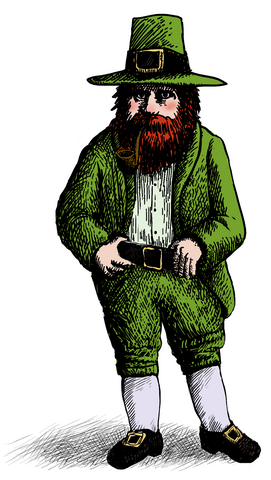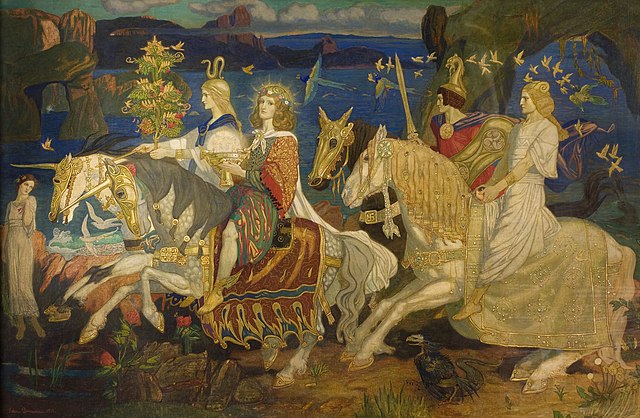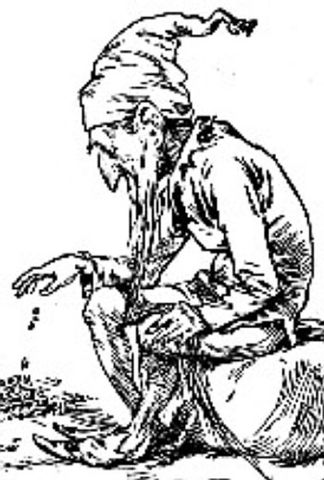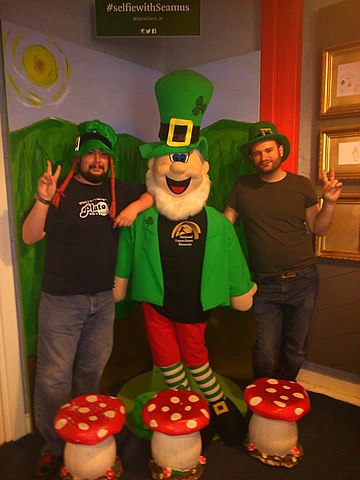The Story of Leprechauns in Ireland
When I was a kid growing up in County Tipperary, we always knew about the stories of Leprechauns in Ireland. As children we were fascinated by the stories of finding enormous pots of gold at the end of rainbows.
These stories captivated us so much that one day, a group of friends and I, spying a rainbow in the distance, decided to go on an adventure and find this pot of gold.
The rainbow appeared in the distance not too far from our homes, so we thought it wouldn’t be too long until we bagged ourselves a treasure. We took off on our adventure, like little hobbits leaving the shire for the first time with the hope of finding a great pot of gold.
We travelled down past our local school to the bottom of a road where we came across a problem. You see, none of us had gone beyond this road out of fear of the man with the black bag who stole children.
At the end of this road was field where our parents had told us a story of a man who lived in the field and would steal children. He would take the children, put them in a black bag, and they would never be seen again.
This fear foiled our adventure as we couldn’t risk being caught by this mysterious man with his black bag. So we turned around, a little sad that we wouldn’t be rich with gold, and returned home.
As you can see, Irish stories have been used throughout the ages to inspire young and old minds as well as preventing children from wandering too far from home.
Using stories in Ireland has always been a way to pass on our heritage as well as entertain. In this article, I will discuss the story behind one of Ireland’s most remarkable figures, the Leprechaun.
I hope that by passing on this information on, I can help keep Ireland’s old stories and traditions alive and inspire new adventures in the future.
I have included a little story about a meeting between a farmer and a Leprechaun at the bottom of this article for you to enjoy.
Table of Contents
The Irish Leprechaun

When you think of Ireland, what comes to mind? Rolling green hills, charming villages, and perhaps, the mischievous little Leprechaun. These pint-sized fairies are a delightful part of Irish folklore and have captivated imaginations worldwide.
Leprechauns in Ireland, often depicted as small, bearded men in green coats and buckled shoes, are more than just amusing characters; they play a significant role in Ireland’s rich tapestry of myths and legends.
In traditional Irish folklore, leprechauns in Ireland are known for their playful and elusive nature. They are said to be solitary creatures who make and mend shoes.
Legend has it that they guard hidden pots of gold, and Leprechauns can be very tricky when keeping their treasures safe. This blend of mystery and mischief has made leprechauns in Ireland famous far beyond Ireland’s shores.
But their charm doesn’t stop at folklore. Leprechauns have danced their way into popular culture, appearing in everything from movies and cartoons to festive parades and souvenirs.
They’ve become symbols of Irish culture, embodying the fun, magical spirit people worldwide love celebrating. So, let’s delve into the enchanting world of leprechauns in Ireland and uncover the magic behind these iconic little fairies!
Origins of Leprechauns in Ireland

The story of leprechauns in Ireland begins in the ancient myths and legends. These tiny fairies have been a part of Irish folklore for centuries. Still, their origins can be traced back to early Irish mythology.
The earliest references to leprechauns appear in tales from the 8th century, where they are described as part of a larger group of supernatural beings known as the “leprechaun” or ‘luchorpán’ which means small body.
In these old stories, leprechauns were not the jolly, green-clad figures we think of today. Instead, they were more like solitary and sometimes grumpy fairies who loved to play tricks on people.
Over time, the image of leprechauns in Ireland and beyond has evolved. By the Middle Ages, they began to be depicted as small, old men dressed in green. This image became more popular and solidified the Leprechaun’s place in Irish folklore.
Leprechauns started to be seen as mischievous but not particularly nasty. They were known for hiding pots of gold and playing tricks on anyone who tried to find them.
It’s important to note that leprechauns in Ireland are just one type of fairy in Irish mythology. Ireland’s folklore is rich with many different kinds of fairies, each with their own unique characteristics.
For example, the “sidhe” (pronounced shee) is a type of fairy that lives in the hills and is often associated with magical and mysterious powers.
So, while leprechauns in Ireland share the fairy tag with other mythical beings, they have their own special place in Irish stories.
Their unique charm and the evolution of their legend make them a fascinating and beloved part of Ireland’s rich mythological heritage.
What Do Leprechauns Look Like?

Leprechauns in Ireland have a distinct look that has evolved over the years but are always small and full of personality. Let’s explore how their appearance has changed and what traits make them memorable.
Typical Appearance
Traditionally, leprechauns are described as tiny, elderly men. They’re usually portrayed as being about 2 to 3 feet tall, with a slightly wrinkled face and a beard. Their clothing is a big part of their look: they often wear a green coat, hat, and buckled shoes.
While now quite iconic, this green attire wasn’t always the norm. In earlier tales, leprechauns in Ireland might have worn simple brown or grey clothes. Still, the green outfit became popular over time, especially in modern depictions.
Common Traits
Leprechauns are known for their playful and sometimes tricky nature. They love to play pranks and are known to be very clever. Historically, they were seen as solitary creatures who made and repaired shoes. This craftiness is often reflected in their appearance, with their neat, well-maintained outfits.
Evolution in Literature
In literature, the image of the Leprechaun has evolved along with their stories. In ancient texts, they were often depicted as grumpy and solitary figures with a more muted appearance. As stories became more modern, especially from the 18th century onwards, leprechauns in Ireland started to be shown as jolly and approachable, with their green clothing and cheerful demeanour.
In contemporary books, movies, and cartoons, leprechauns are frequently depicted as having a mix of humour and mischief. They might have magical powers or be involved in humorous adventures. Their look has become more standardised, with the green coat and hat becoming nearly universal.
So, in ancient myths or today’s media, leprechauns are instantly recognisable by their small size, distinctive clothing, and playful, clever nature. They continue to charm and entertain people of all ages, keeping their magical essence alive in every story they appear.
Leprechauns in Irish Folklore
Leprechauns are not just cute characters in stories; they play an important role in Irish folklore with their unique myths and legends. Explore some of the most intriguing stories and explore their magical world.
Stories and Myths
One of the most famous leprechaun stories is about their hidden treasure. According to legend, leprechauns have pots of gold that they bury at the end of rainbows. If you can catch a leprechaun, he might promise to reveal the location of his treasure in exchange his release. However, leprechauns in Ireland are incredibly tricky and rarely make it easy for anyone to find their gold!
Please read the bottom of this article for a story about the Farmer and the Leprechaun.
Role in Irish Fairy Lore
In Irish fairy lore, leprechauns are part of a larger group of magical beings known as the “fairies” or “sidhe.” Unlike other fairies who might live in enchanted forests or hills, leprechauns are typically portrayed as living in hidden, secret places. Unlike other more social fairies, they are solitary and prefer to keep to themselves.
Magical Powers and Treasure
Leprechauns in Ireland are believed to have magical powers, though they use them mainly to protect their treasure. Their gold is often seen as a symbol of luck and wealth.
According to legend, if you catch a leprechaun, he might try to trick you with illusions or spells to keep his gold hidden. Some stories even say that leprechauns in Ireland have the power to grant wishes or bestow good fortune if they’re feeling generous—or if they’re caught off guard!
Their association with treasure has made them symbols of both mystery and wealth. The idea of finding a pot of gold at the end of a rainbow has become a famous symbol of luck and good fortune, largely thanks to these mischievous little fairies.
So, in Irish folklore, leprechauns are more than just playful characters—they are keepers of magical secrets and symbols of hidden treasure, adding a touch of mystery and excitement to the rich tapestry of Irish myths.
The Leprechaun and the Pot of Gold
The image of a leprechaun with a pot of gold is one of the most famous symbols of Irish folklore. But where did this idea come from, and how has it changed over time?
Origins of the Pot of Gold Myth
The legend of the pot of gold is rooted in old Irish tales. In these stories, leprechauns in Ireland are known for hiding their treasure very carefully. It is said that they bury their pots of gold at the end of a rainbow.
This image comes from the idea that rainbows are magical and elusive, just like the treasure the leprechauns guard. Since rainbows seem to have no natural end, it makes sense that the gold would be just as hard to find!
In earlier myths, the pot of gold wasn’t always the main focus. Leprechauns were more often seen as solitary fairies who loved to play tricks. However, over time, stories began to emphasise the idea that leprechauns had hidden treasures that people desperately wanted to find.
Evolution in Modern Culture

In modern times, the image of the Leprechaun and his pot of gold has become even more popular and widely recognised. This story has been featured in countless books, movies, and advertisements.
The pot of gold has come to symbolise not just hidden wealth but also good luck and the magical possibilities that lie just beyond reach.
For example, in movies and cartoons, leprechauns are often shown guarding their gold with elaborate traps or magical powers to keep it safe from treasure hunters.
The idea of a pot of gold at the end of the rainbow has become a famous symbol of hope and dreams coming true.
During celebrations like St. Patrick’s Day, leprechauns and their pots of gold are often used to decorate and promote festivities. The colourful image of the Leprechaun with his gold pot is a fun and cheerful part of the celebrations, bringing a touch of magic to the occasion.
So, from its origins in Irish folklore to its place in modern culture, the Leprechaun’s pot of gold has evolved into a symbol of magic, mystery, and the excitement of discovering hidden treasure. It captures our imagination and adds a little sparkle to the world of fairies and legends.
The Legend of the Irish Leprechaun
Leprechauns have danced their way through centuries of Irish folklore, captivating our imaginations with their mischievous charm and magical secrets. From their humble beginnings in ancient myths to their colourful appearances in modern culture, these tiny fairies have enchanted people worldwide.
Their legendary pot of gold and playful tricks remind us of the magic and mystery that lies beyond the ordinary. Whether hiding treasure at the end of a rainbow or playing tricks in their hidden workshops, leprechauns continue to symbolise wonder and whimsy.
As we explore these ancient myths and legends, we not only celebrate the rich tapestry of Irish folklore but also keep the magic of leprechauns alive in our own stories and traditions. So the next time you see a rainbow, remember: there might be a little bit of leprechaun magic waiting to be discovered!
Leprechaun Story
The Farmer and the Leprechaun
One such tale passed down through the generations was of a local farmer who came across a strange sound on his way home from having a few jars (pints) in the local pub one evening.
As he was walking along a small lane not far from his home, he heard the sound of a hammer tapping on a nail from beyond a hedge in a small field. Peering over the hedge, he set his eyes on the smallest man he had ever seen, sitting on a stool, mending an old pair of shoes.
Now, after a few pints of porter in the local public house, he first thought his eyes must be betraying him, and his senses had left him. Without further thought, he jumped over the hedge and grabbed the little man with both hands.
Once he caught hold of this little man he realised what he had done, he had caught himself a leprechaun. He jumped about, happy as can be that his luck had finally come in.
“Okay, okay, you have caught me,” the Leprechaun said to the farmer. If you would kindly let me down, I will give you whatever you ask for,” the Leprechaun said slightly angrily.
Now, the farmer, being a few sheets to the wind, still had enough of his senses to know that if he let the Leprechaun go, he would be gone in the blink of an eye. You see, it’s common knowledge that Leprechauns are one of the trickiest fairy folk around. To catch one is a feat in itself, but if you take your eye off them, you may never see them again.
“No,” said the farmer to the Leprechaun, “I shall not let you down until you show me where you have buried your pot of gold.” For you see, it was also common knowledge that if you caught a Leprechaun, they would hand over their pot of gold to be set free.
Begrudgingly, the Leprechaun agreed and pointed to a nearby forest where he said his treasure of gold was buried under a tree. The Leprechaun agreed he would show the farmer which tree if he would set him free, to which the farmer agreed.
The Leprechaun directed the farmer into the middle of the forest, and under the moonlight, they stopped at a small tree. This tree looked very similar to many others in this moonlit forest.
“How can I trust you that this is the correct tree and you are not tricking me?” said the farmer, for it was common knowledge that Leprechauns are the trickiest of tricksters.
“By my oath, may my hammer fail and my leather run dry, I swear to you I shall not lie,” the leprechaun replied to the farmer. With this oath, the farmer set the Leprechaun down, and in the blink of an eye, he was gone.
Now, the farmer had a problem, for in front of him stood a tree where the buried treasure lay and him with no shovel to dig a hole.
“I have an idea,” said the farmer to himself, “I’ll take off one of my socks, hang it on the tree branch, and come back tomorrow morning and dig up my treasure”.
Now, for someone who was after a few pints of porter and one or two glasses of whiskey, this sounded like a fantastic idea.
So, with a bit of struggle, he managed to kick off one of his boots and tugged at his red sock, which had a hole where his big toe usually poked out. He grabbed the nearest branch and hung the red sock with the hole from the branch.
He put his boot back on and wobbled off home for the night, singing merrily and thinking he was one of the luckiest men in Ireland.
The next morning, with a bit of a sore porter head up on him, the farmer struggled out of bed. He popped on his best working boots, ignoring the fact he was only wearing one sock, grabbed his coat and shovel and headed off down the lane.
When he reached the field where he caught the Leprechaun, he walked across to the nearby forest; the thundering cloud in his head forgotten by the thought of digging up a wealth of gold.
All he needed to do was find the tree with his red sock and dig up the gold, and he would be rich and set for life. As he walked into the forest, he was greeted with the shock of his life. Every single tree in the forest had a red sock hanging from a branch, with a hole in it where a toe usually poked out. The farmer couldn’t believe his eyes as he fell to his knees and cursed the Leprechauns and their tricky ways.
Related Articles:
Here is a list of articles that provide more information on some of our Irish Culture, Myths, and Legends.
Further Reading
“The Leprechaun’s Gold” by Pamela Duncan Edwards
- A delightful children’s book that explores leprechaun lore and the magic behind their legendary treasure.
“The Fairies in Irish Tradition and Folklore” by W. B. Yeats
- A classic work by the renowned poet, offering deep insights into the role of fairies, including leprechauns, in Irish tradition.
